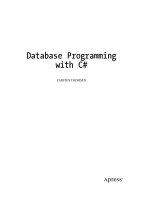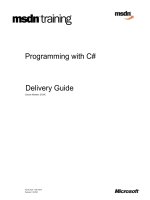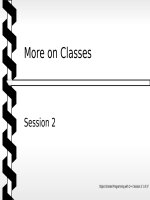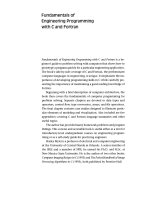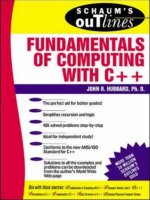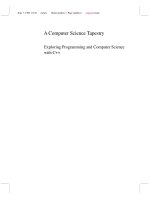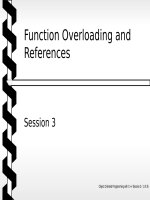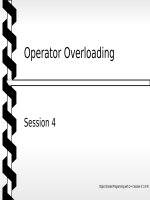John r hubbard programming with c++, 2nd ed (2000)
Bạn đang xem bản rút gọn của tài liệu. Xem và tải ngay bản đầy đủ của tài liệu tại đây (4.46 MB, 434 trang )
SCHAUM’S OUTLINE OF
THEORY AND PROBLEMS
of
PROGRAMMING
WITH C++
Second Edition
·
JOHN R. HUBBARD, Ph.D.
Professor of Mathematics and Computer Science
University of Richmond
·
SCHAUM’S OUTLINE SERIES
McGRAW-HILL
New York San Francisco Washington, D.C. Auckland Bogota′ Caracas
Lisbon London Madrid Mexico City Milan Montreal
New Delhi San Juan Singapore Sydney Tokyo Toronto
Copyright © 2000, 1996 by the McGraw-Hill Companies. All rights reserved. Manufactured in the United States of America. Except as permitted
under the United States Copyright Act of 1976, no part of this publication may be reproduced or distributed in any form or by any means, or stored in
a database or retrieval system, without the prior written permission of the publisher.
0-07-136811-6
The material in this eBook also appears in the print version of this title: ISBN 0-07-135346-1.
All trademarks are trademarks of their respective owners. Rather than put a trademark symbol after every occurrence of a trademarked name, we
use names in an editorial fashion only, and to the benefit of the trademark owner, with no intention of infringement of the trademark. Where such
designations appear in this book, they have been printed with initial caps.
McGraw-Hill eBooks are available at special quantity discounts to use as premiums and sales promotions, or for use in corporate training pro-
grams. For more information, please contact George Hoare, Special Sales, at or (212) 904-4069.
TERMS OF USE
This is a copyrighted work and The McGraw-Hill Companies, Inc. (ÒMcGraw-HillÓ) and its licensors reserve all rights in and to t he work. Use of
this work is subject to these terms. Except as permitted under the Copyright Act of 1976 and the right to store and retrieve one copy of the work,
you may not decompile, disassemble, reverse engineer, reproduce, modify, create derivative works based upon, transmit, distribute, disseminate,
sell, publish or sublicense the work or any part of it without McGraw-HillÕ s prior consent. You may use the work for your own noncommercial
and personal use; any other use of the work is strictly prohibited. Your right to use the work may be terminated if you fail to comply with these
terms.
THE WORK IS PROVIDED ÒAS ISÓ. McGRA W-HILL AND ITS LICENSORS MAKE NO GUARANTEES OR WARRANTIES AS TO THE
ACCURACY, ADEQUACY OR COMPLETENESS OF OR RESULTS TO BE OBTAINED FROM USING THE WORK, INCLUDING ANY
INFORMATION THAT CAN BE ACCESSED THROUGH THE WORK VIA HYPERLINK OR OTHERWISE, AND EXPRESSLY DISCLAIM
ANYWARRANTY, EXPRESS OR IMPLIED, INCLUDING BUT NOT LIMITED TO IMPLIED WARRANTIES OF MERCHANTABILITY OR
FITNESS FOR A PARTICULAR PURPOSE. McGraw-Hill and its licensors do not warrant or guarantee that the functions contained in the work
will meet your requirements or that its operation will be uninterrupted or error free. Neither McGraw-Hill nor its licensors shall be liable to you
or anyone else for any inaccuracy, error or omission, regardless of cause, in the work or for any damages resulting therefrom. McGraw-Hill has
no responsibility for the content of any information accessed through the work. Under no circumstances shall McGraw-Hill and/or its licensors be
liable for any indirect, incidental, special, punitive, consequential or similar damages that result from the use of or inability to use the work, even
if any of them has been advised of the possibility of such damages. This limitation of liability shall apply to any claim or cause whatsoever whether
such claim or cause arises in contract, tort or otherwise.
abc
McGraw-Hill
DOI: 10.1036/0071368116
iii
Preface
Like all Schaum’s Outline Series books, this volume is intended to be used primarily for self
study, preferably in conjunction with a regular course in C++ programming language or
computer science. However, it is also well-suited for use in independent study or as a reference.
The book includes over 200 examples and solved problems. The author firmly believes that
the principles of data structures can be learned from a well-constructed collection of examples
with complete explanations. This book is designed to provide that support.
C++ was created by Bjarne Stroustrup in the early 1980s. Based upon C and Simula, it is
now one of the most popular languages for object-oriented programming. The language was
standardized in 1998 by the American National Standards Institute (ANSI) and the International
Standards Organization (ISO). This new ANSI/ISO Standard includes the powerful Standard
Template Library (STL). This book conforms to these standards.
Although most people who undertake to learn C++ have already had some previous
programming experience, this book assumes none. It approaches C++ as one’s first programming
language. Therefore, those who have had previous experience may need only skim the first few
chapters.
C++ is a difficult language for at least two reasons. It inherits from the C language an
economy of expression that novices often find cryptic. And as an object-oriented language, its
widespread use of classes and templates presents a formidable challenge to those who have not
thought in those terms before. It is the intent of this book to provide the assistance necessary for
first-time programmers to overcome these obstacles.
Source code for all the examples and problems in this book, including the Supplementary
Problems, may be downloaded from these websites
,
/> Any corrections or addenda for the book will also be
available at these sites.
I wish to thank all my friends, colleagues, students, and the McGraw-Hill staff who have
helped me with the critical review of this manuscript, including John Aliano, Arthur Biderman,
Francis Minhthang Bui, Al Dawson, Peter Dailey, Mohammed El-Beltagy, Gary Galvez, Libbie
Geiger, Sergei Gorlatch, Chris Hanes, John B. Hubbard, Raana Jeelani, Dick Palas, Blake Puhak,
Arni Sigurjonsson, Andrew Somers, Joe Troncale, Maureen Walker, Stefan Wentzig, and Nat
Withers. Their editorial advice and debugging skills are gratefully appreciated.
Special thanks to my wife and colleague, Anita H. Hubbard, for her advice, encouragement,
and creative ideas for this book. Many of the original problems used here are hers.
J
OHN R. HUBBARD
Richmond, Virginia
Copyright 2000 The McGraw-Hill Companies, Inc. Click Here for Terms of Use.
This page intentionally left blank.
v
Contents
Chapter1 ElementaryC++Programming 1
1.1 GETTINGSTARTED 1
1.2 SOMESIMPLEPROGRAMS 2
1.3 THEOUTPUTOPERATOR 4
1.4 CHARACTERSANDLITERALS 4
1.5 VARIABLESANDTHEIRDECLARATIONS 5
1.6 PROGRAMTOKENS 6
1.7 INITIALIZINGVARIABLES 7
1.8 OBJECTS,VARIABLES,ANDCONSTANTS 7
1.9 THEINPUTOPERATOR 8
Chapter2 FundamentalTypes 16
2.1 NUMERICDATATYPES 16
2.2 THEBOOLEANTYPE 17
2.3 ENUMERATIONTYPES 17
2.4 CHARACTERTYPES 19
2.5 INTEGERTYPES 19
2.6 ARITHMETICOPERATORS 21
2.7 THEINCREMENTANDDECREMENTOPERATORS 21
2.8 COMPOSITEASSIGNMENTOPERATORS 22
2.9 FLOATING-POINTTYPES 23
2.10 TYPE CONVERSIONS 25
2.11 NUMERICOVERFLOW 26
2.12 ROUND-OFF ERROR 28
2.13 THEE-FORMATFORFLOATING-POINTVALUES 30
2.14 SCOPE 31
Chapter3 Selection 36
3.1 THE if STATEMENT 36
3.2 THE if else STATEMENT 36
3.3 KEYWORDS 37
3.4 COMPARISONOPERATORS 38
3.5 STATEMENTBLOCKS 39
3.6 COMPOUND CONDITIONS 41
3.7 SHORT-CIRCUITING 42
3.8 BOOLEANEXPRESSIONS 42
3.9 NESTEDSELECTIONSTATEMENTS 43
3.10 THE else if CONSTRUCT 46
3.11 THE switch STATEMENT 47
3.12 THE CONDITIONAL EXPRESSION OPERATOR 49
Copyright 2000 The McGraw-Hill Companies, Inc. Click Here for Terms of Use.
vi CONTENTS
Chapter4 Iteration 60
4.1 THE while STATEMENT 60
4.2 TERMINATINGALOOP 62
4.3 THE do while STATEMENT 64
4.4 THE for STATEMENT 65
4.5 THE break STATEMENT 71
4.6 THE continue STATEMENT 73
4.7 THE goto STATEMENT 74
4.8 GENERATING PSEUDO-RANDOM NUMBERS 75
Chapter5 Functions 87
5.1 INTRODUCTION . . . 87
5.2 STANDARDC++LIBRARYFUNCTIONS 87
5.3 USER-DEFINEDFUNCTIONS 90
5.4 TESTDRIVERS 90
5.5 FUNCTIONDECLARATIONSANDDEFINITIONS 92
5.6 LOCALVARIABLESANDFUNCTIONS 95
5.7 void FUNCTIONS 96
5.8 BOOLEANFUNCTIONS 98
5.9 I/OFUNCTIONS 101
5.10 PASSINGBYREFERENCE 102
5.11 PASSINGBYCONSTANTREFERENCE 106
5.12 INLINEFUNCTIONS 107
5.13 SCOPE 108
5.14 OVERLOADING 109
5.15 THE main() FUNCTION 109
5.16 DEFAULTARGUMENTS 111
Chapter6 Arrays 126
6.1 INTRODUCTION . . . 126
6.2 PROCESSINGARRAYS 126
6.3 INITIALIZINGANARRAY 127
6.4 ARRAY INDEX OUT OF BOUNDS 129
6.5 PASSINGANARRAYTOAFUNCTION 131
6.6 THELINEARSEARCHALGORITHM 133
6.7 THEBUBBLESORTALGORITHM 134
6.8 THEBINARYSEARCHALGORITHM 134
6.9 USINGARRAYSWITHENUMERATIONTYPES 137
6.10 TYPEDEFINITIONS 138
6.11 MULTIDIMENSIONAL ARRAYS . 139
CONTENTS vii
Chapter7 PointersandReferences 156
7.1 THEREFERENCEOPERATOR 156
7.2 REFERENCES 157
7.3 POINTERS 158
7.4 THEDEREFERENCEOPERATOR 159
7.5 DERIVEDTYPES 161
7.6 OBJECTSANDLVALUES 162
7.7 RETURNINGAREFERENCE 162
7.8 ARRAYSANDPOINTERS 163
7.9 DYNAMIC ARRAYS 168
7.10 USING const WITHPOINTERS 169
7.11 ARRAYSOFPOINTERSANDPOINTERSTOARRAYS 170
7.12 POINTERSTOPOINTERS 170
7.13 POINTERSTOFUNCTIONS 170
7.14 NUL, NULL, AND void 172
Chapter8 C-Strings 183
8.1 INTRODUCTION . . . 183
8.2 REVIEWOFPOINTERS 183
8.3 C-STRINGS 185
8.4 STRINGI/O 186
8.5 SOME cin MEMBERFUNCTIONS 187
8.6 STANDARDCCHARACTERFUNCTIONS 190
8.7 ARRAYSOFSTRINGS 191
8.8 STANDARDCSTRINGFUNCTIONS 193
Chapter9 StandardC++Strings 213
9.1 INTRODUCTION . . . 213
9.2 FORMATTEDINPUT 213
9.3 UNFORMATTEDINPUT 214
9.4 THE STANDARD C++ string TYPE 216
9.5 FILES 217
9.6 STRINGSTREAMS 219
Chapter10 Classes 232
10.1 INTRODUCTION . . . 232
10.2 CLASSDECLARATIONS 232
10.3 CONSTRUCTORS 235
10.4 CONSTRUCTORINITIALIZATIONLISTS 237
10.5 ACCESSFUNCTIONS 238
10.6 PRIVATEMEMBERFUNCTIONS 238
10.7 THECOPYCONSTRUCTOR 240
10.8 THECLASSDESTRUCTOR 242
10.9 CONSTANTOBJECTS 243
10.10 STRUCTURES 243
10.11 POINTERSTOOBJECTS 244
10.12 STATICDATAMEMBERS 245
10.13 static FUNCTIONMEMBERS 247
viii CONTENTS
Chapter11 OverloadingOperators 256
11.1 INTRODUCTION . . . 256
11.2 OVERLOADING THE ASSIGNMENT OPERATOR . . . 256
11.3 THE this POINTER 256
11.4 OVERLOADING ARITHMETIC OPERATORS . 258
11.5 OVERLOADING THE ARITHMETIC ASSIGNMENT OPERATORS 260
11.6 OVERLOADING THE RELATIONAL OPERATORS . . 260
11.7 OVERLOADING THE STREAM OPERATORS . 261
11.8 CONVERSION OPERATORS 263
11.9 OVERLOADING THE INCREMENT AND DECREMENT OPERATORS . . . . . 264
11.10 OVERLOADING THE SUBSCRIPT OPERATOR 266
Chapter12 CompositionandInheritance 273
12.1 INTRODUCTION . . . 273
12.2 COMPOSITION 273
12.3 INHERITANCE 275
12.4 protected CLASSMEMBERS 276
12.5 OVERRIDINGANDDOMINATINGINHERITEDMEMBERS 278
12.6 private ACCESS VERSUS protected ACCESS 281
12.7 virtual FUNCTIONSANDPOLYMORPHISM 282
12.8 VIRTUALDESTRUCTORS 285
12.9 ABSTRACTBASECLASSES 286
12.10 OBJECT-ORIENTEDPROGRAMMING 290
Chapter13 TemplatesandIterators 300
13.1 INTRODUCTION . . . 300
13.2 FUNCTIONTEMPLATES 300
13.3 CLASSTEMPLATES 302
13.4 CONTAINERCLASSES 304
13.5 SUBCLASSTEMPLATES 306
13.6 PASSINGTEMPLATECLASSESTOTEMPLATEPARAMETERS 307
13.7 ACLASSTEMPLATEFORLINKEDLISTS 309
13.8 ITERATORCLASSES 312
Chapter14 StandardC++Vectors 324
14.1 INTRODUCTION . . . 324
14.2 ITERATORSONVECTORS 326
14.3 ASSIGNINGVECTORS 327
14.4 THE erase() and insert() FUNCTIONS 328
14.5 THE find() FUNCTION 329
14.6 THE C++ STANDARD vector CLASSTEMPLATE 331
14.7 RANGE CHECKING . 332
Chapter15 ContainerClasses 338
15.1 ANSI/ISO STANDARD C++ 338
15.2 THE STANDARD TEMPLATE LIBRARY 338
15.3 STANDARDC++CONTAINERCLASSTEMPLATES 338
15.4 STANDARDC++GENERICALGORITHMS 339
15.5 HEADERFILES 340
CONTENTS ix
AppendixA CharacterCodes 342
A.1 TheASCIICode 342
A.2 Unicode 346
AppendixB StandardC++Keywords 348
AppendixC StandardC++Operators 351
AppendixD StandardC++ContainerClasses 353
D.1 THE vector CLASSTEMPLATE 353
D.2 THE deque CLASSTEMPLATE 358
D.3 THE stack CLASSTEMPLATE 359
D.4 THE queue CLASSTEMPLATE 359
D.5 THE priority_queue CLASSTEMPLATE 360
D.6 THE list CLASSTEMPLATE 361
D.7 THE map CLASSTEMPLATE 363
D.8 THE set CLASSTEMPLATE 365
AppendixE StandardC++GenericAlgorithms 367
AppendixF TheStandardCLibrary 396
AppendixG HexadecimalNumbers 401
AppendixH References 405
Index 409
This page intentionally left blank.
Dedicated to
Anita H. Hubbard
1
Chapter 1
Programming is best regarded as
the process of creating works of literature,
which are meant to be read.
—Donald E. Knuth
Elementary C++ Programming
A program is a sequence of instructions that can be executed by a computer. Every program is
written in some programming language. C++ (pronounced “see-plus-plus”) is one of the most
powerful programming languages available. It gives the programmer the power to write
efficient, structured, object-oriented programs.
1.1 GETTING STARTED
To write and run C++ programs, you need to have a text editor and a C++ compiler installed
on your computer. A text editor is a software system that allows you to create and edit text files
on your computer. Programmers use text editors to write programs in a programming language
such as C++. A compiler is a software system that translates programs into the machine language
(called binary code) that the computer’s operating system can then run. That translation process
is called compiling the program. A C++ compiler compiles C++ programs into machine
language.
If your computer is running a version of the Microsoft Windows operating system (e.g.,
Windows 98 or Windows 2000), then it already has two text editors: WordPad and Notepad.
These can be started from the
Start key. In Windows 98, they are listed under Accessories.
Windows does not come with a built-in C++ compiler. So unless someone has installed a C++
compiler on the machine you are using, you will have to do that yourself. If you are using a
Windows computer that is maintained by someone else (e.g., an Information Services depart-
ment at your school or company), you may find a C++ compiler already installed. Use the
Start
key to look under Programs for Borland C++Builder, Metrowerks CodeWarrior, Microsoft Visual
C++, or any other program with “C++” in its name. If you have to buy your own C++ compiler,
browse the Web for inexpensive versions of any of the compilers mentioned above. These are
usually referred to as IDEs (Integrated Development Environments) because they include their
own specialized text editors and debuggers.
If your computer is running a proprietary version of the UNIX operating system on a worksta-
tion (e.g., Sun Solaris on a SPARCstation), it may already have a C++ compiler installed. An
easy way to find out is to create the program shown in Example 1.1 on page 2, name it
hello.C,
and then try to compile it with the command
CC hello
The Free Software Foundation has a suite of UNIX software, named “GNU” software that can
be downloaded for free from
/>Copyright 2000 The McGraw-Hill Companies, Inc. Click Here for Terms of Use.
2 ELEMENTARY C++ PROGRAMMING [CHAP. 1
Use their GCC package which includes a C++ compiler and their Emacs editor. For DOS
systems, use their DJGPP which includes a C++ compiler.
1.2 SOMESIMPLEPROGRAMS
Now you have a text editor for writing C++ programs and a C++ compiler for compiling
them. If you are using an IDE such as Borland C++Builder on a PC, then you can compile and
run your programs by clicking on the appropriate buttons. Other systems may require you to use
the command line to run your programs. In that case, you do so by entering the file name as a
command. For example, if your source code is in a file named
hello.cpp, type
hello
at the command line to run the program after it has been compiled.
When writing C++ programs, remember that C++ is case-sensitive. That means that
main()
is different from Main(). The safest policy is to type everything in lower-case except when you
have a compelling reason to capitalize something.
EXAMPLE 1.1 The “Hello, World” Program
This program simply prints “Hello, World!”:
#include <iostream>
int main()
{ std::cout << "Hello, World!\n";
}
The first line of this source code is a preprocessor directive that tells the C++ compiler where to find
the definition of the
std::cout object that is used on the third line. The identifier iostream is the
name of a file in the Standard C++ Library. Every C++ program that has standard input and output must
include this preprocessor directive. Note the required punctuation: the pound sign
# is required to
indicate that the word “
include” is a preprocessor directive; the angle brackets <>are required to
indicate that the word “
iostream” (which stands for “input/output stream”) is the name of a Standard
C++ Library file. The expression
<iostream> is called a standard header.
The second line is also required in every C++ program. It tells where the program begins. The identi-
fier
main is the name of a function, called the main function of the program. Every C++ program must
have one and only one
main() function. The required parentheses that follow the word “main” indicate
that it is a function. The keyword
int is the name of a data type in C++. It stands for “integer”.Itisused
here to indicate the return type for the
main() function. When the program has finished running, it can
return an integer value to the operating system to signal some resulting status.
The last two lines constitute the actual body of the program. A program body is a sequence of program
statements enclosed in braces
{}. In this example there is only one statement:
std::cout << "Hello, World!\n";
It says to send the string "Hello, World!\n" to the standard output stream object std::cout.
The single symbol
<< represents the C++ output operator. When this statement executes, the characters
enclosed in quotation marks
""are sent to the standard output device which is usually the computer
screen. The last two characters
\n represent the newline character. When the output device encounters
that character, it advances to the beginning of the next line of text on the screen. Finally, note that every
program statement must end with a semicolon (
;).
Notice how the program in Example 1.1 is formatted in four lines of source code. That format-
ting makes the code easier for humans to read. The C++ compiler ignores such formatting. It
CHAP. 1] ELEMENTARY C++ PROGRAMMING 3
reads the program the same as if it were written all on one line, like this:
#include <iostream>
int main(){std::cout<<"Hello, World!\n";}
Blank spaces are ignored by the compiler except where needed to separate identifiers, as in
int main
Note that the preprocessor directive must precede the program on a separate line.
EXAMPLE 1.2 Another “Hello, World” Program
This program has the same output as that in Example 1.1:
#include <iostream>
using namespace std;
int main()
{ // prints "Hello, World!":
cout << "Hello, World!\n";
return 0;
}
The second line
using namespace std;
tells the C++ compiler to apply the prefix std:: to resolve names that need prefixes. It allows us to use
cout in place of std::cout. This makes larger programs easier to read.
The fourth line
{ // prints "Hello, World!"
includes the comment “prints "Hello, World!"”.Acomment in a program is a string of characters
that the preprocessor removes before the compiler compiles the programs. It is included to add explana-
tions for human readers. In C++, any text that follows the double slash symbol
//,uptotheendofthe
line, is a comment. You can also use C style comments, like this:
{ /* prints "Hello, World!" */
A Cstylecomment(introduced by the programming language named “C”) is any string of characters
between the symbol
/* and the symbol */. These comments can run over several lines.
The sixth line
return 0;
is optional for the main() function in Standard C++. We include it here only because some compilers
expect it to be included as the last line of the
main() function.
A namespace is a named group of definitions. When objects that are defined within a
namespace are used outside of that namespace, either their names must be prefixed with the
name of the namespace or they must be in a block that is preceded by a
using namespace
statement. Namespaces make it possible for a program to use different objects with the same
name, just as different people can have the same name. The
cout object is defined within a
namespace named
std (for “standard”)inthe <iostream> header file.
Throughout the rest of this book, every program is assumed to begin with the two lines
#include <iostream>
using namespace std;
These two required lines will be omitted in the examples. We will also omit the line
return 0;
from the main() function. Be sure also to include this line if you are using a compiler (such as
Microsoft Visual C++) that expects it.
4 ELEMENTARY C++ PROGRAMMING [CHAP. 1
1.3 THE OUTPUT OPERATOR
The symbol
<< is called the output operator in C++. (It is also called the put operator or the
stream insertion operator.) It inserts values into the output stream that is named on its left. We
usually use the
cout output stream, which ordinarily refers to the computer screen. So the state-
ment
cout << 66;
would display the number 66 on the screen.
An operator is something that performs an action on one or more objects. The output operator
<< performs the action of sending the value of the expression listed on its right to the output
stream listed on its left. Since the direction of this action appears to be from right to left, the
symbol
<< was chosen to represent it. It should remind you of an arrow pointing to the left.
The
cout object is called a “stream” because output sent to it flows like a stream. If several
things are inserted into the
cout stream, they fall in line, one after the other as they are dropped
into the stream, like leaves falling from a tree into a natural stream of water. The values that are
inserted into the
cout stream are displayed on the screen in that order.
EXAMPLE 1.3 Yet Another “Hello, World” Program
This program has the same output as that in Example 1.1:
int main()
{ // prints "Hello, World!":
cout << "Hel" << "lo, Wo" << "rld!" << endl;
}
The output operator is used four times here, dropping the four objects "Hel", "lo, Wo", "rld!",and
endl into the output stream. The first three are strings that are concatenated together (i.e., strung
end-to-end) to form the single string
"Hello, World!". The fourth object is the stream manipulator
object
endl (meaning “end of line”). It does the same as appending the endline character '\n' to the
string itself: it sends the print cursor to the beginning of the next line. It also “flushes” the output buffer.
1.4 CHARACTERS AND LITERALS
The three objects
"Hel", "lo, Wo",and"rld!" in Example 1.3 are called string literals.
Each literal consists of a sequence of characters delimited by quotation marks.
A character is an elementary symbol used collectively to form meaningful writing. English
writers use the standard Latin alphabet of 26 lower case letters and 26 upper case letters along
with the 10 Hindu-Arabic numerals and a collection of punctuation marks. Characters are stored
in computers as integers. A character set code is a table that lists the integer value for each
character in the set. The most common character set code in use at the end of the millennium is
the ASCII Code, shown in Appendix A. The acronym (pronounced “as-key”) stands for Ameri-
can Standard Code for Information Interchange.
The newline character
'\n' is one of the nonprinting characters. It is a single character
formed using the backslash
\ and the letter n. There are several other characters formed this way,
including the horizontal tab character
'\t' and the alert character '\a'. The backslash is also
used to denote the two printing characters that could not otherwise be used within a string literal:
the quote character
\" and the backslash character itself \\.
CHAP. 1] ELEMENTARY C++ PROGRAMMING 5
Characters can be used in a program statement as part of a string literal, or as individual
objects. When used individually, they must appear as character constants. A character constant is
a character enclosed in single quotes. As individual objects, character constants can be output the
samewaystringliteralsare.
EXAMPLE 1.4 A Fourth Version of the “Hello, World” Program
This program has the same output as that in Example 1.1:
int main()
{ // prints "Hello, World!":
cout << "Hello, W" << 'o' << "rld" << '!' << '\n';
}
This shows that the output operator can process characters as well as string literals. The three individual
characters
'o', '!',and'\n' are concatenated into the output the same was as the two string literals
"Hello, W" and "rld".
EXAMPLE 1.5 Inserting Numeric Literals into the Standard Output Stream
int main()
{ // prints "The Millennium ends Dec 31 2000.":
cout << "The Millennium ends Dec " <<3<<1<<''<< 2000 << endl;
}
When numeric literals like 3 and 2000 are passed to the output stream they are automatically
converted to string literals and concatenated the same way as characters. Note that the blank character
(
'') must be passed explicitly to avoid having the digits run together.
1.5 VARIABLES AND THEIR DECLARATIONS
A variable is a symbol that represents a storage location in the computer’s memory. The infor-
mation that is stored in that location is called the value of the variable. One common way for a
variable to obtain a value is by an assignment. This has the syntax
variable = expression;
First the expression is evaluated and then the resulting value is assigned to the variable.The
equals sign “
=” is the assignment operator in C++.
EXAMPLE 1.6 Using Integer Variables
In this example, the integer 44 is assigned to the variable m, and the value of the expression m+33
is assigned to the variable n:
int main()
{ // prints "m = 44 and n = 77":
int m, n;
m = 44; // assigns the value 44 to the variable m
cout << "m="<<m;
n=m+33; //assigns the value 77 to the variable n
cout << " andn="<<n<<endl;
}
The output from the program is shown in the shaded panel at the top of the next page.
6 ELEMENTARY C++ PROGRAMMING [CHAP. 1
We can view the variables m and n like this:
The variable named
m is like a mailbox. Its name
m is like the address on a mailbox, its value 44 is like the contents of a mailbox, and its type int is like a
legal classification of mailboxes that stipulates what may be placed inside it. The type
int means that the
variable holds only integer values.
Note in this example that both
m and n are declared on the same line. Any number of variables can be
declared together this way if they have the same type.
Every variable in a C++ program must be declared before it is used. The syntax is
specifier type name initializer;
where specifier is an optional keyword such as const (see Section 1.8), type is one of the
C++ data types such as
int, name isthenameofthevariable,andinitializer is an optional
initialization clause such as
=44 (see Section 1.7).
The purpose of a declaration is to introduce a name to the program; i.e., to explain to the
compiler what the name means. The
type tells the compiler what range of values the variable
may have and what operations can be performed on the variable.
The location of the declaration within the program determines the scope of the variable: the
part of the program where the variable may be used. In general, the scope of a variable extends
from its point of declaration to the end of the immediate block in which it is declared or which it
controls.
1.6 PROGRAM TOKENS
A computer program is a sequence of elements called tokens. These tokens include keywords
such as
int, identifiers such as main, punctuation symbols such as {, and operators such as <<.
When you compile your program, the compiler scans the text in your source code, parsing it into
tokens. If it finds something unexpected or doesn’t find something that was expected, then it
aborts the compilation and issues error messages. For example, if you forget to append the
semicolon that is required at the end of each statement, then the message will report the missing
semicolon. Some syntax errors such as a missing second quotation mark or a missing closing
brace may not be described explicitly; instead, the compiler will indicate only that it found
something wrong near that location in your program.
EXAMPLE 1.7 A Program’sTokens
int main()
{ // prints "n = 44":
int n=44;
cout << "n="<<n<<endl;
}
The output is
This source code has 19 tokens: “
int”, “main”, “(”, “)”, “{”, “int”, “n”, “=”, “44”, “;”, “cout”,
“
<<”, “"n="”, “<<”, “n”, “<<”, “endl”, “;”,and“}”. Note that the compiler ignores the comment
symbol
// and the text that follows it on the second line.
m=44andn=77
44m
int
77n
int
n=44
CHAP. 1] ELEMENTARY C++ PROGRAMMING 7
EXAMPLE 1.8 An Erroneous Program
This is the same program as above except that the required semicolon on the third line is missing:
int main()
{ // THIS SOURCE CODE HAS AN ERROR:
int n=44
cout << "n="<<n<<endl;
}
One compiler issued the following error message:
Error : ';' expected
Testing.cpp line 4 cout
<<"n="<<n<<endl;
This compiler underlines the token where it finds the error. In this case, that is the “cout” token at the
beginning of the fourth line. The missing token was not detected until the next token was encountered.
1.7 INITIALIZING VARIABLES
In most cases it is wise to initialize variables where they are declared.
EXAMPLE 1.9 Initializing Variables
This program contains one variable that is not initialized and one that is initialized.
int main()
{ // prints "m = ?? and n = 44":
int m; // BAD: m is not initialized
int n=44;
cout << "m="<<m<<"andn="<<n<<endl;
}
The output is shown in the shaded box.
This compiler handles uninitialized variables in a special way. It gives them a special value that appears
as
?? when printed. Other compilers may simply leave “garbage” in the variable, producing output like
this:
In larger programs, uninitialized variables can cause troublesome errors.
1.8 OBJECTS, VARIABLES, AND CONSTANTS
An object is a contiguous region of memory that has an address, a size, a type, and a value.
The address of an object is the memory address of its first byte. The size of an object is simply
the number of bytes that it occupies in memory. The value of an object is the constant determined
by the actual bits stored in its memory location and by the object’s type which prescribes how
thosebitsaretobeinterpreted.
For example, with GNU C++ on a UNIX workstation, the object
n defined by
int n = 22;
has the memory address 0x3fffcd6, the size 4, the type int, and the value 22. (The memory
address is a hexadecimal number. See Appendix G.)
m=??andn=44
m = -2107339024 and n = 44
8 ELEMENTARY C++ PROGRAMMING [CHAP. 1
The type of an object is determined by the programmer. The value of an object may also be
determined by the programmer at compile time, or it may be determined at run-time. The size of
an object is determined by the compiler. For example, in GNU C++ an
int has size 4, while in
Borland C++ its size is 2. The address of an object is determined by the computer’s operating
system at run-time.
Some objects do not have names. A variable is an object that has a name. The object defined
above is a variable with name ‘
n’.
The word “variable” is used to suggest that the object’s value can be changed. An object
whose value cannot be changed is called a constant. Constants are declared by preceding its type
specifier with the keyword
const, like this:
const intN=22;
Constants must be initialized when they are declared.
EXAMPLE 1.10 The const Specifier
This program illustrates constant definitions:
int main()
{ // defines constants; has no output:
const char BEEP = '\b';
const int MAXINT = 2147483647;
const int N = MAXINT/2;
const float KM_PER_MI = 1.60934;
const double PI = 3.14159265358979323846;
}
Constants are usually defined for values like π that will be used more than once in a program
but not changed.
It is customary to use all capital letters in constant identifiers to distinguish them from other
kinds of identifiers. A good compiler will replace each constant symbol with its numeric value.
1.9 THE INPUT OPERATOR
In C++, input is almost as simple as output. The input operator
>> (also called the get opera-
tor or the extraction operator) works like the output operator
<<.
EXAMPLE 1.11 Using the Input Operator
int main()
{ // tests the input of integers, floats, and characters:
int m, n;
cout << "Enter two integers: ";
cin>>m>>n;
cout << "m = " << m << ", n="<<n<<endl;
double x, y, z;
cout << "Enter three decimal numbers: ";
cin>>x>>y>>z;
cout << "x = " << x << ", y="<<y<<",z="<<z<<endl;
char c1, c2, c3, c4;
cout << "Enter four characters: ";
CHAP. 1] ELEMENTARY C++ PROGRAMMING 9
cin >> c1 >> c2 >> c3 >> c4;
cout << "c1 = " << c1 << ", c2="<<c2<<",c3="<<c3
<<",c4="<<c4<<endl;
}
The input is shown in boldface in the output panel.
Review Questions
1.1 Describe the two ways to include comments in a C++ program.
1.2 What is wrong with this program?
#include <iostream>
int main()
{ // prints "Hello, World!":
cout << "Hello, World!\n"
}
1.3 What is wrong with the following C-style comment?
cout << "Hello, /* change? */ World.\n";
1.4 What’s wrong with this program:
#include <iostream>;
int main
{ // prints "n = 22":
n = 22;
cout << "n = << n << endl;
}
1.5 What does a declaration do?
1.6 What is the purpose of the preprocessing directive:
#include <iostream>
1.7 What is the shortest possible C++ program?
1.8 Where does the name “C++” come from?
1.9 What’s wrong with these declarations:
int first = 22, last = 99, new = 44, old = 66;
1.10 In each of the following, assume that m has the value 5 and n has the value 2 before the
statement executes. Tell what the values of m and n will be after each of the following
statements executes:
a. m *= n++;
b. m += n;
1.11 Evaluate each of the following expressions, assuming in each case that m has the value 25
and n has the value 7:
a. m-8-n
b. m=n=3
c. m%n
d. m%n++
e. m%++n
f. ++m - n
Enter two integers: 22 44
m= 22,n=44
Enter three decimal numbers: 2.2 4.4 6.6
x = 2.2, y = 4.4, z = 6.6
Enter four characters: ABCD
c1= A,c2=B,c3=C,c4=D
10 ELEMENTARY C++ PROGRAMMING [CHAP. 1
1.12 Parse the following program, identifying all the keywords, identifiers, operators, literals,
punctuation, and comments:
int main()
{ int n;
cin >> n;
n *= 3; // multiply n by 3
cout << "n=" << n << endl;
}
1.13 Identify and correct the error in each of the following:
a.
cout >> count;
b. int double=44;
1.14 How do the following two statements differ:
char ch = 'A';
char ch = 65;
1.15 What code could you execute to find the character whose ASCII code is 100?
1.16 What does “floating-point” mean, and why is it called that?
1.17 What is numeric overflow?
1.18 How is integer overflow different from floating-point overflow?
1.19 What is a run-time error? Give examples of two different kinds of run-time errors.
1.20 What is a compile-time error? Give examples of two different kinds of compile-time errors.
Problems
1.1 Write four different C++ statements, each subtracting 1 from the integer variable n.
1.2 Write a block of C++ code that has the same effect as the statement
n = 100 + m++;
without using the post-increment operator.
1.3 Write a block of C++ code that has the same effect as the statement
n = 100 + ++m;
without using the pre-increment operator.
1.4 Write a single C++ statement that subtracts the sum of
x and y from z and then
increments y.
1.5 Write a single C++ statement that decrements the variable
n andthenaddsitto total.
1.6 Write a program that prints the first sentence of the Gettysburg Address (or your favorite
quotation).
1.7 Write a program that prints the block letter “B” in a 7 × 6 grid of stars like this:
*****
**
**
*****
**
**
*****
1.8 Write and run a program that prints the first letter of your last name as a block letter in a
7 × 7gridofstars.
1.9 Write and run a program that shows what happens when each of the following ten “escape
sequences” is printed:
\a, \b, \n, \r, \t, \v, \', \", \\, \?.
1.10 Write and run a program that prints the sum, difference, product, quotient, and remainder of
two integers. Initialize the integers with the values 60 and 7.
CHAP. 1] ELEMENTARY C++ PROGRAMMING 11
1.11 Write and run a program that prints the sum, difference, product, quotient, and remainder of
two integers that are input interactively.
1.12 Write and run a test program that shows how your system handles uninitialized variables.
1.13 Write and run a program that causes negative overflow of a variable of type
short.
1.14 Write and run a program that demonstrates round-off error by executing the following steps:
(1) initialize a variable
a of type float with the value 666666; (2) initialize a variable b of
type float with the value 1-1/a; (3) initialize a variable c of type float with the value
1/b - 1; (4) initialize a variable d of type float with the value 1/c + 1; (5) print all four
variables. Show algebraically that
d = a even though the computed value of d ≠ a.Thisis
caused by round-off error.
Answers to Review Questions
1.1 One way is to use the standard C style comment
/* like this */
The other way is to use the standard C++ style comment
// like this
The first begins with a slash-star and ends with a star-slash. The second begins with a double-slash and
ends at the end of the line.
1.2 The semicolon is missing from the last statement.
1.3 Everything between the double quotes will be printed, including the intended comment.
1.4 There are four errors: the precompiler directive on the first line should not end with a semicolon, the
parentheses are missing from main(), n is not declared, and the quotation mark on the last line has
no closing quotation mark.
1.5 A declaration tells the compiler the name and type of the variable being declared. It also may be ini-
tialized in the declaration.
1.6 It includes contents of the header file iostream into the source code. This includes declarations
needed for input and output; e.g., the output operator <<.
1.7 int main() { }
1.8 The name refers to the C language and its increment operator ++. The name suggests that C++ is an
advance over C.
1.9 The only thing wrong with these declarations is that new is a keyword. Keywords are reserved and
cannot be used for names of variables. See
Appendix B for a list of the 62 keywords in C++.
1.10 a. m will be 10 and n will be 3.
b. m will be 6 and n will be 1.
1.11 a. m-8-nevaluates to (25 - 8) - 7 = 17 - 7 = 10
b. m=n=3evaluates to 3
1.12 a. m-8-nevaluates to (25 - 8) - 7 = 17 - 7 = 10
b. m=n=3evaluates to 3
c. m%n evaluates to 25%7 = 4
d. m%n++ evaluates to 25%(7++) = 25%7 = 4
e. m%++n evaluates to 25%(++7) = 25%8 = 1
f. ++m - n evaluates to (++25) - (7 ) = 26 - 7 = 19
1.13 The keyword is int. The identifiers are main, n, cin, cout,andendl. The operators are (), >>,
*=,and <<. The literals are 3 and "n=". The punctuation symbols are {, ;,and }.Thecomment
is “// multiply n by 3”.
1.14 a. The output object cout requires the output operator <<. It should be cout << count;
b. The word double is a keyword in C++; it cannot be used as a variable name. Use: int d=44;
12 ELEMENTARY C++ PROGRAMMING [CHAP. 1
1.15 Both statements have the same effect: they declare ch to be a char and initialize it with the value 65.
Since this is the ASCII code for 'A', that character constant can also be used to initialize ch to 65.
1.16 cout << "char(100) = " << char(100) << endl;
1.17 The term “floating-point” is used to describe the way decimal numbers (rational numbers) are stored
in a computer. The name refers to the way that a rational number like 386501.294 can be represented
in the form 3.86501294×10
5
by letting the decimal point “float” to the left 5 places.
1.18 Numeric overflow occurs in a computer program when the size of a numeric variable gets too big for
its type. For example, on most computers values variables of type short cannot exceed 32,767, so if
a variable of that type has the value 32,767 and is then incremented (or increased by any arithmetic
operation), overflow will occur.
1.19 When integer overflow occurs the value of the offending variable will “wrap around” to negative val-
ues, producing erroneous results. When floating-point overflow occurs, the value of the offending
variable will be set to the constant inf representing infinity.
1.20 A run-time error is an error that occurs when a program is running. Numeric overflow and division by
zero are examples of run-time errors.
1.21 A compile-time error is an error that occurs when a program is being compiled. Examples: syntax
errors such as omitting a required semicolon, using an undeclared variable, using a keyword for the
name of a variable.
Solutions to Problems
1.1 Four different statements, each subtracting 1 from the integer variable n:
a. n=n-1;
b. n-=1;
c. n;
d. n ;
1.2 n=100+m;
++m;
1.3 ++m;
n=100+m;
1.4 z -= (x + y++);
1.5 total += n;
1.6 int main()
{ // prints the first sentence of the Gettysburg Address
cout << "\tFourscore and seven years ago our fathers\n";
cout << "brought forth upon this continent a new nation,\n";
cout << "conceived in liberty, and dedicated to the\n";
cout << "proposition that all men are created equal.\n";
}
1.7 int main()
{ // prints "B" as a block letter
cout << "*****" << endl;
cout << "* *" << endl;
cout << "* *" << endl;
cout << "*****" << endl;
cout << "* *" << endl;
cout << "* *" << endl;
Fourscore an
d
seven years ago our
f
at
h
ers
brought forth upon this continent a new nation,
conceived in liberty, and dedicated to the
proposition that all men are created equal.
CHAP. 1] ELEMENTARY C++ PROGRAMMING 13
cout << "*****" << endl;
}
1.8 int main()
{ // prints "W" as a block letter
cout << "* *" << endl;
cout << " * *" << endl;
cout << " * *" << endl;
cout << " * * *" << endl;
cout << " * * * *" << endl;
cout << " * * * *" << endl;
cout << " * *" << endl;
}
1.9 int main()
{ // prints escape sequences
cout << "Prints \"\\nXXYY\": " << "\nXXYY" << endl;
cout << " " << endl;
cout << "Prints \"\\nXX\\bYY\": " << "\nXX\bYY" << endl;
cout << " " << endl;
cout << "Prints \"\\n\\tXX\\tYY\": " << "\n\tXX\tYY" << endl;
cout << " " << endl;
cout << "Prints the \'\\a\' character: " << '\a' << endl;
cout << " " << endl;
cout << "Prints the \'\\r\' character: " << '\r' << endl;
cout << " " << endl;
cout << "Prints the \'\\v\' character: " << '\v' << endl;
cout << " " << endl;
cout << "Prints the \'\\?\' character: " << '\?' << endl;
cout << " " << endl;
}
*****
**
**
*****
**
**
*****
**
**
**
***
****
** **
**
Prints the '\v' character:
Prints the '\?' character: ?
Prints "\nXXYY":
XXYY
Prints "\nXX\bYY":
XYY
Prints "\n\tXX\tYY":
